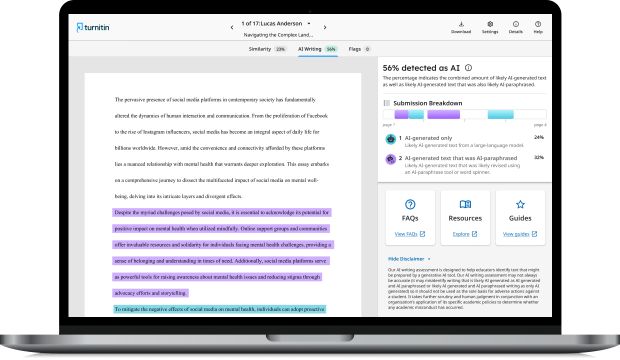Comprehending the Relevance of an Ai Detector in Today's Digital Landscape
As synthetic knowledge continues to permeate various elements of web content creation, comparing human-generated and machine-generated material has actually come to be significantly complex. This evolving landscape offers considerable obstacles associated with credibility and credibility, demanding the development of AI discovery tools. These tools not only aid in determining AI-produced web content but also promote the integrity of details dissemination. Recognizing their function becomes crucial as we navigate a future where the integrity of media is under continuous examination. What implications might this have for customers and creators alike?
The Increase of AI Material

The increase of AI-generated web content has significant effects for various industries, including amusement, advertising, and journalism - ai detector. Organizations are increasingly making use of these technologies to boost performance, personalize material, and engage audiences better. The capacity to analyze huge datasets permits AI systems to customize content to fulfill particular user preferences, providing a more customized experience
Nevertheless, the expansion of AI material also increases vital factors to consider for web content developers and customers alike. As AI becomes more incorporated into content production process, recognizing the nuances of AI-generated material is essential for keeping quality and relevance in a rapidly progressing electronic atmosphere. Welcoming this technical development while continuing to be watchful concerning its implications is important for stakeholders in the electronic media landscape.
Challenges of Authenticity
The introduction of AI-generated web content has introduced considerable obstacles pertaining to authenticity in digital media. As algorithms end up being extra sophisticated, comparing machine-generated and human-created web content becomes progressively tough. This blurring of lines increases concerns about the integrity of details and the possibility for false information to proliferate.
One of the primary challenges is the erosion of trust among consumers. With AI capable of producing reasonable text, images, and videos, individuals might locate it testing to recognize real resources from misleading ones. This apprehension can bring about a more comprehensive skepticism of all electronic material, complicating efforts to recognize reputable details.
In addition, the effects for intellectual residential or commercial property are substantial. As AI devices create material based on existing jobs, inquiries relating to ownership and creativity emerge. Material developers may battle to secure their work from uncredited AI recreations, weakening their source of incomes and legal rights.
Lastly, the possibility for harmful uses AI-generated material, such as deepfakes and automated publicity, presents serious moral and societal threats. These difficulties underscore the immediate need for structures that support credibility in the digital landscape, making certain that info continues to be trustworthy and trustworthy.
Duty of AI Detectors
Dealing with the obstacles of authenticity in digital media needs cutting-edge services, and AI detectors have actually arised as a crucial device in this initiative. These technologies are developed to examine and recognize content produced by expert system, thereby helping why not check here with the discernment in between machine-generated and human-created products. The function of AI detectors prolongs past plain recognition; they also add to maintaining the stability of info taken in by the public.
AI detectors make use of innovative formulas to look at various elements of digital content, including linguistic patterns, structural anomalies, and particular markers that suggest automation. Their application covers several industries, including journalism, education, and social networks, where the existence of AI-generated material can cause misinformation and erosion of count on.
Advantages of Using AI Detectors
Making certain authenticity view publisher site in electronic material symbolizes the fundamental need for count on details sources, and AI detectors work as a powerful ally in this pursuit. By identifying AI-generated content, these devices assist keep the integrity of info, consequently securing users from misinformation and boosting overall material quality.
One of the main benefits of utilizing AI detectors is their capacity to simplify material verification processes, significantly lowering the moment and effort needed to examine the credibility of digital products. This performance permits material creators, instructors, and businesses to focus on generating dependable and top notch info, instead than spending too much resources on fact-checking.
Additionally, AI detectors foster responsibility among material makers. The understanding that AI-generated web content can be recognized urges transparency and honest techniques in material manufacturing. This, in turn, adds to a more enlightened electronic area, as customers can confidently engage with verified details.
Future of Material Confirmation
As the landscape of digital web content proceeds to evolve, the future of content confirmation offers both challenges and opportunities for preserving credibility. As AI modern technologies breakthrough, so also do the approaches for disseminating and developing false information (ai detector). This arms race in between content developers and confirmation tools requires the growth of extra sophisticated AI detectors with the ability of discerning real content from controlled or produced product

Furthermore, the increase of decentralized modern technologies, such as blockchain, holds promise for confirming content provenance, making certain that users can trace the origins of the info they eat. Inevitably, the future of web content verification will certainly hinge on our capacity to innovate in the face of advancing risks, promoting an electronic environment where credibility is recognized and promoted as a basic concept.
Conclusion
In verdict, the proliferation of AI-generated material demands durable mechanisms for credibility confirmation. The future of content verification hinges on the effectiveness of AI detectors in maintaining integrity across various media platforms.
AI article web content production devices, such as all-natural language processing versions and generative adversarial networks, allow organizations and individuals to generate top quality material at unprecedented rates and lower expenses.
However, the expansion of AI web content also increases vital factors to consider for content makers and consumers alike. As the sophistication of AI-generated material continues to evolve, the role of AI detectors comes to be progressively crucial in securing credibility and promoting openness in digital interaction. The expertise that AI-generated web content can be recognized encourages transparency and moral methods in web content manufacturing.As the landscape of electronic content continues to progress, the future of material verification tests both provides and opportunities for preserving authenticity.